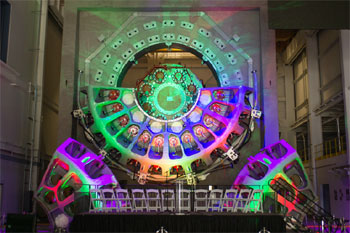One of the world’s most advanced wind turbine testing facilities is open in Charleston, South Carolina, where some of the biggest turbines under development – especially for offshore wind – will be tested and validated for performance, durability, and reliability.
Companies like Vestas, Siemens and General Electric will pay to test their biggest prototypes here, simulating how they perform in the harshest weather conditions imaginable.
New generation turbines are so enormous – a 15 MW turbine can power 4500 homes and weigh up to 400 tons – that they are too big to be tested anywhere else.
An old, 82,000 square foot warehouse on a former Navy base has been transformed to test the turbines, which range in size from 7.5 megawatts (MW) to 15 MW.
Using rigs up to four stories high, the biggest has an 11,000-horsepower motor that simulates the impact of hurricanes on turbines.

Engineers will be able to simulate 20 years worth of wear and tear on turbines in just 6-8 months, and a grid simulator will test how they interact with the power grid during power outages, physical attacks and other real world conditions.
"The idea is to break them, so we know how and where these turbines and drivetrains fail over time," John Kelly, executive director of Clemson University’s Restoration Institute, which houses the facility, told Bloomberg BusinessWeek.
The Large Wind Turbine Drivetrain Testing facility is supported by $46 million from the Department of Energy (from the Recovery Act) and $53 million from interested parties, such as General Electric, Shell and Duke Energy.
"The Clemson testing facility represents a critical investment to ensure America leads in this fast-growing global industry – helping to make sure the best, most efficient wind energy technologies are developed and manufactured in the United States," says Dan Poneman, Deputy Secretary of the Department of Energy (DOE).
This latest facility rounds out US capabilities for testing turbines, critical for the wind industry:
- Smaller turbines, from 400 watts to 5 MW are tested at National Renewable Energy Lab’s National Wind Technology Center in Boulder, Colorado, open since 1993, but received equipment to test 5 MW turbines last week.
- Large wind turbine blades are being tested at a new facility in Boston, near a $100 million offshore wind port that’s under development.
- For the first time, research is moving beyond individual turbines to how wind turbines interact on a wind farm (to improve wind farm performance) at the SWiFT facility (Scaled Wind Farm Technology) in Lubbock, Texas.
- Regional testing centers for small turbines are in Utah, Texas, Kansas and New York.
The latest research shows, for example, that staggering wind turbines – rather than lining them up – can increase wind farm production some 33%. "Some estimates show that 10-40% of wind energy production and revenue is lost due to complex wind plant interaction," notes Jon White of Sandia’s Wind Energy Technologies Department.
Learn more about wind farm performance:

Awesome
Incredible!